EESE 6/1995 - 101
Dagmar Haumann (Wuppertal)
Sentential adjuncts
Contents
The purpose of this paper is to describe the syntactic structure
of sentential adjuncts in English within the Theory of Principles
and Parameters as described in Chomsky (1986).
On the basis of their internal syntax, I will distinguish
sentential adjuncts that involve syntactic movement, i.e. verb
EESE 6/1995 - 102
movement or wh-movement, from sentential adjuncts that are
lexically overtly introduced as subordinate by a so-called
subordinating conjunction. Whereas the former can be unambiguously
assigned the status of functional projections or, to use
Grimshaw's (1991) terminology, as extended verbal projections, the
latter cannot in toto be assigned the status of functional or
lexical projections.
It will be shown that, although their internal structure is
anything but homogeneous, the external structure of the sentential
adjuncts investigated is similar in all cases. It is homogeneous
insofar as all three types of sentential adjuncts can be
characterized as predicates.
Predicatehood, it will be argued, can be either a derived property
of maximal projections or a lexically determined one.
The outline of this paper is as follows: In section 1, I briefly
review the categorization problem traditionally associated with
subordinating conjunctions that introduce adjunct clauses.
Section 2 discusses three types of sentential adjuncts. The focus
in 2.1 is on sentential adjuncts that involve syntactic movement.
Subordinate clauses which are derived by verb movement will be
central in 2.1.1, those derived by wh-movement will be central in
2.1.2. Section 2.2 concentrates on sentential adjuncts that are
introduced by a so-called subordinating conjunction.
Section 3 summarizes the main results of the investigation.
EESE 6/1995 - 103
The syntactic category of sentence-introducing elements such as
after, although, because, before, for, in case, since, until, when
and while has always been and still is problematic: In traditional
grammar (Deutschbein and Klitscher 1959; Schibsbye 1965; Allen
and Mason 1939/1965; Sweet 1891), these elements, on the basis
of their syntactic function, are almost always assigned the status of
subordinating conjunctions introducing adverbial clauses. Although
most traditional grammarians emphasize the fact that some of these
elements, e.g. after, before, since, are polyfunctional, i.e. one
and the same item may function as a subordinating conjunction, as
a preposition and sometimes as an adverb, they do not see them as
elements belonging to one syntactic category.
Jespersen (1924/1992:89) concludes that the fact that one and the
same word, sometimes with slight differences, is used as a
subordinating conjunction and as a preposition "[...] should not
make us hesitate to affirm the essential identity of prepositions
and conjunctions [...]".
Jespersen's (1924/1992:89) insights are systematically
incorporated into generative grammar in Jackendoff (1973,1977) and
Emonds (1976,1985). Subordinating conjunctions, prepositions and
certain adverbs are categorized as prepositions which take
sentential complements or nominal complements, or which occur
intransitively.
EESE 6/1995 - 104
Jackendoff (1977), for example, distinguishes prepositions that
function as subordinating conjunctions from subordinating elements
such as that and for, which since Rosenbaum (1967) are referred to
as complementizers. Other authors, e.g. Lasnik & Saito (1992),
Grimshaw (1991), Vikner (1994), take all subordinating
conjunctions as instances of the category C, i.e. as
complementizers.
With the integration of so-called minor categories, such as
determiners, complementizers and auxiliaries, into X-bar Theory
and the consequent division of the universe of lexical items in
lexical categories and functional categories, the longstanding
question of whether subordinating conjunctions are to be
categorized as prepositions or as complementizers is eclipsed by
the question whether prepositions are lexical or functional
categories or whether the set of elements referred to as
prepositions straddles the lexical and the functional universe.
The same questions must be raised with respect to subordinating
conjunctions: are they lexical or functional heads, or do they
straddle the lexical and the functional universe?
In the light of this lexical-functional dichotomy, which gained
importance especially with respect to L(exical)-marking, movement
theory and parametric variation, a precise categorization of
lexical elements is indispensable.
In the following I want to approach the categorization of
subordinating conjunctions in terms of lexical and functional
categoryhood rather than in terms of category labels such as
preposition or complementizer.
EESE 6/1995 - 105
In order to find evidence for either categorization, both the
external structure and the internal structure of adverbial
subordinate clauses have to be investigated.
The set of subordinate constructions this paper is concerned with
is exemplified in (1):
(1)
- Had she taken her medicine, she might be better now.
- If she had taken her medicine, she might be better now.
- I left the office when I noticed that it was well past 8 p.m.
- Although her painting career was interrupted, she helped her husband and continued
to accumulate painting knowledge.
- I seemed to know what they were going to say long before they said it.
Within the framework of Principles and Parameters, the external
structure of the subordinate clauses in (1) is, by and large,
considered uncontroversial: as they are not L(exically)-marked,
they function as adjuncts. Thus, movability of sentential adjuncts
as well as non-extractability of elements from them, i.e. their
barrier status, is predicted.
EESE 6/1995 - 106
Yet, it is not entirely clear how these adjuncts combine with the
matrix clause, i.e. how sentence embedding is technically
achieved.
A major problem in describing sentential adjuncts lies in the
internal structure and in the categorial status of these
constructs. This, for the reasons given above, is most obvious in
those constructions which are introduced by so-called
subordinating conjunctions.
In the following I shall compare three kinds of sentential
adjuncts: sentential adjuncts that are introduced by subordinating
conjunctions, sentential adjuncts that are introduced by a wh-
moved constituent and sentential adjuncts that are introduced by a
verbal element. Whereas the last two types of subordinate clauses
are derived by syntactic movement, the first type is lexically
overtly marked as subordinate.
The following two subsections focus on sentential adjuncts which
involve syntactic movement.
The first type, which I will call the verb-first (V1) variant,
involves overt verb movement into the highest functional head
EESE 6/1995 - 107
position of the sentence, i.e. the finite verbal form leaves IP:
(2)
- Had she taken her medicine, she might be better now.
- Should you wish to attend class, please be on time.
- Were she to be on time, we might take the bus at 8 p.m.
In their cross-linguistic study on Conditional Inversion, Iatridou
and Embick (1994:2) observe that finite V1 adjunct sentences are
always interpreted as conditionals (henceforth V1-conditionals).
Whereas, according to their study (1994:3), English allows for
conditional inversion only in counterfactual conditionals (3),
German, for example, displays conditional inversion in both
counterfactual and indicative conditionals (4).
(3)
- Had she taken her medicine, she might be better now.
- Has she taken her medicine, she might be better now.
(4)
- Hätte sie ihre Medizin genommen, ginge es ihr besser.
- Nimmt sie ihre Medizin, geht es ihr besser.
In conditional inversion structures, the finite verb leaves its
base position and head-moves into the highest functional head
position of the sentence, as is indicated in (5):
EESE 6/1995 - 108
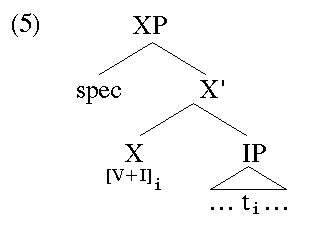
According to standard assumptions about head movement and
projections, the head X counts as a functional head which figures
within the extended verbal projection. XP in turn is the highest
extended projection of the verb, arguably CP.
EESE 6/1995 - 109
What is relevant with respect to the conditional adjuncts in (2)
is that the word order in these adjuncts is marked, i.e. it
diverges from the regular word order in embedded sentences as in
(6):
(6)
- If she had taken her medicine, she might be better now.
- If you should wish to attend class, please be on time.
- If she were to be on time, we might take the bus at 8 p.m.
Sentential adjuncts that are overtly introduced by a subordinating
conjunction do not allow for internal verb movement.
The fact that the finite verb and the subordinating conjunction
are mutually exclusive in X, can be taken as evidence that both
elements, the finite verb and if, compete for the same structural
position.
The internal structure of the phrases in (6) thus corresponds to
(2), the only difference being that the head position X is filled
by the finite verb in (5) above and with if in (7):
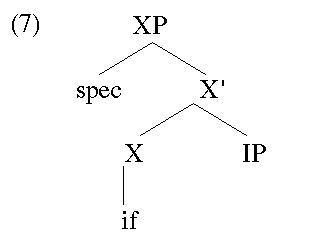
EESE 6/1995 - 110
Evidence for the fact that the finite verb and the subordinating
conjunction are mutually exclusive comes mainly from V2
languages, where finite verbs in embedded clauses introduced
by a subordinating conjunction are generally in final position.
Embedded V2 in subordinate clauses is restricted to bridge contexts,
i.e. embedded contexts in which, due to the lexical properties of
the governing verb, the subordinating conjunction may be missing,
thus vacating the highest functional head position for the finite verb
(cf. Müller & Sternefeld (1993:488ff.)).
Among the array of adjunct sentences, V1-conditionals are the only
structures that do not display the well-known asymmetry of matrix
vs. embedded clauses (Rizzi and Roberts 1989; Grimshaw 1994),
i.e. they allow for the verb to move to the highest functional head
position. With regard to the question of how V1-embedding is technically
achieved, linguistic theory, to my knowledge, seems to be at a
loss for an explanation.
In recent research, however, Grimshaw (1993,1994) proposes an
analysis of V1-conditionals as well as conditionals introduced by
if as operator constructions, the structure of which is given in
(8):
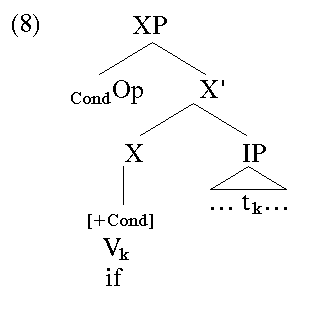
EESE 6/1995 - 111
What is relevant here is that the specifier and the head agree in
their features, i.e. both are marked as [+Cond]. This requirement
can be considered a "relative" of Rizzi's (1991a) WH-Criterion.
The head position, as we have already seen, is either filled by
the moved finite verb as in (2) or the subordinating conjunction
if as in (6). The specifier position, in both cases, contains the
conditional operator which agrees with the head, i.e. agreement
surfaces either as a special verb form as in (3a) & (4a), or as
the conditional subordinator if as in (6).
Analyzing V1-conditionals as operator constructions - an analysis
under which, in fact, they are verb-second - gives an explanation
of how these constructions embed into the matrix. It can be
assumed that V1-conditionals, since they contain an operator, are
complex predicates in the sense of Williams (1980) and Browning
(1989).
Williams (1980:209) defines wh-operator constructions together
with sentences containing PRO as complex predicates; i.e. clauses
which correspond to the structure given in (9) can function as
predicates:
EESE 6/1995 - 112
(9)
- [ PRO VP ]S
- [ {PRO/WH} S ]S'
(Williams 1980:209)
Wh-elements as well as PRO, under his analysis, qualify as
predicate variables, i.e. as elements which turn non-predicates,
i.e. S and S', into predicates. In these cases, predicatehood is
achieved by vertically binding the predicate variable, thus it is
visible on S or S' (cf. Williams (1987:434)).
As is pointed out by Browning (1991:25f.), Williams' vertical
binding mechanism can be readily integrated into the framework of
Principles and Parameters. Since X, by percolation and specifier-
head agreement, agrees with both its maximal projection and its
specifier, as indicated in (10), the information that XP is a
predicate is visible on XP:
EESE 6/1995 - 113
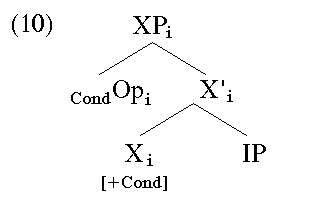
EESE 6/1995 - 114
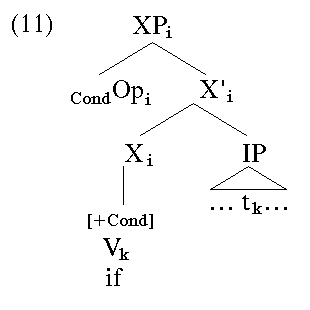
EESE 6/1995 - 115
I assume that this indexing mechanism carries over to the
conditional constructions in (8). By virtue of the conditional
operator, the XPs in (11) are predicates.
This form of predication differs from the standard cases of
predication which involve the discharging of the external
argument (Higginbotham 1985; Williams 1980; Speas 1990;
Haumann 1990, 1993; Zwarts 1992). As the XP in (11) does
not have an external argument, predication, in this case,
has to be characterized as non-thematic (Browning 1991:23).
The analysis presented in (11) has two effects: First, we are in
a position to explain why the highest functional head must be filled
(i.e. specifier-head-agreement) and second, we can describe the
maximal projection XP as a predicate and thus capture embedding
into the matrix.
The second type of sentential adjunct I want to discuss involves
wh-movement, but not verb movement, which, in fact, is I-to-C movement.
The availability of verb movement is distinctive with respect to the
classification of matrix wh-movement vs. embedded wh-movement.
In both cases of wh-movement, i.e. embedded and matrix wh-move-
ment, the "landing site" for wh-moved elements is the specifier position
of some functional head.
The asymmetry of matrix vs. embedded clauses with respect to verb
movement into the highest functional head was originally stated
EESE 6/1995 - 116
for selected contexts, i.e. for argument positions, but carries
over to all embedded contexts, except in V1-conditionals (cf.
2.1.1) (Rizzi and Roberts 1989; Grimshaw 1994).
Verbs in embedded clauses, whether selected or not, cannot leave
the IP, as is shown by the ungrammatical examples in (12):
(12)
- *They wondered who(m) should they invite to the party.
- *They wondered whether should they offer them some coffee.
- *They invited the man who(m) have they met in New York.
- *They arrived at the station where had they planned to meet Tom.
- *They arrived at the station when had Tom arrived.
In embedded contexts, as opposed to non-embedded contexts, the
finite verbal form, i.e. the auxiliary or modal, never leaves the
IP, i.e. it is not attracted by the [+wh] operator in specXP.
In general, it seems that in embedded clauses only one position
may be lexically filled, either the head position (by a finite
verbal form as in (2a)-(2c) or by a so-called complementizer (e.g.
that)), or the specifier position.
In Middle English and Early Modern English, however, constructions
with both positions filled can be found. In the examples in (13),
which are taken from Lightfoot (1979:321f.), the specifier
position is filled with a wh-element and the head with that:
ESSE 6/1995 - 117
(13)
- only the sight of hire whom that I serve...wolde han suffised right ynough for me
- syk lay the gode man, whos that the place is
- men shal wel knowe who that I am
- whan that Aprille with his shoures soote...
In modern standard English, however, these constructions do not
occur as the ungrammatical sequences in (14) show:
(14)
- I left the office when (*that) I noticed that it was well past 8 p.m.
- She told everybody to get off at the second stop where (*that) she would meet them.
- When (*that) Mr. Brown sat down, Labor MPs cheered for a full minute.
- When (*that) he escaped, I was hauled over the coals and almost wished I had
escaped with him.
- Where (*that) the fire had been, we saw nothing but blackened ruins.
As we have seen above in (9), wh-elements are syntactic operators
and as such they appear in the highest specifier position of their
construction. In the cases at hand, these wh-elements serve to
mark their clause as subordinate.
EESE 6/1995 - 118
Movement of a [+wh]-phrase into specXP, under specifier-head-agreement
and by percolation, results in making the wh-index
visible on XP. These XPs, by virtue of wh-in-spec, function as
predicates (15):
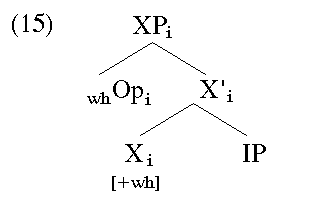
EESE 6/1995 - 119
The embedding of wh-adjunct sentences thus resembles the embedding
of finite V1 adjuncts. The maximal projection functions in both
cases as a complex predicate.
If the target of wh-movement is the specifier position of some
functional head, the obvious question to ask is "what is the
nature of the functional head?".
In the V1-constructions, the head X was unambiguously defined as
the highest functional head in the extended verbal projection.
Concerning the question of whether the head in embedded wh-constructions
is verbal or nominal in nature, I follow, for lack
of counterevidence, Kayne (1982), Webelhuth (1989, 1990), Ouhalla
(1991) and others in assuming that X is verbal if it contains
either a verb or no lexical material at all. Support for the
assumption that the head position is verbal comes from so-called
semi-indirect speech data such as in (16):
(16)
- I wondered what kind of party had he in mind. (Radford (1990:117))
- You asked them would they marry him. (Rizzi (1991a:5))
- I wondered where had he been.
- I wondered was he a liar.
EESE 6/1995 - 120
In these examples, the finite verbal form occupies the highest
functional head position; the structure of these examples is
identical to the structure of matrix wh-questions.
On the basis of these data I assume that the highest extended
projection of adjuncts that involve wh-movement,is a projection of
the verb.
The third type of sentential adjunct under discussion has the
characteristic of being introduced by a so-called subordinating
conjunction.
EESE 6/1995 - 121
Embedded sentences like those in (17) are restricted to non-
argument positions:
(17)
- Although her painting career was interrupted, she helped her husband and continued
to accumulate painting knowledge.
- Small areas aren't right for they may lie next to areas that are well suited to that
crop.
- If we joined the Common Market, our food subsidies would probably be replaced by a
system of tariffs.
- Not only is it these two things that customers want, but they also want well-priced special
offers and we private retailers must take the burden out of everyday shopping and make it as easy as we can
for these shoppers in case we lose their custom.
- The fact that the Queen is expecting a baby will not be official until an official
announcement has been made.
- In some ways it will be a testing occasion for him, although some think his position unassailable
simply because there is no one else in sight to supplant him.
- So if you are made of atoms, you are just a big machine; and since the universe
is also made of atoms, it is just a supermachine.
- From the standpoint of the army of duffers, however, this was easily the most heartening
exhibition they had had since Ben Hogan fell upon evil ways during his heyday and scored an
11 in the Texas Open.
- You will have to wait with your novel until you find a publisher.
- I seemed to know what they were going to say long before they said it.
- Only a few hours after Mr Lloyd and his delegation landed at Accra this morning, hundreds
of shop assistants demonstrated outside the British-owned Kingsway Stores, the largest in town.
- It has been repeatedly pointed out that the Chancellor's measures to restrict sales in the home
market in order to increase exports are quite mistaken and are having the opposite result.
- She got nervous while she was waiting for her publisher to show up.
EESE 6/1995 - 122
Preliminarily, the structure of this type of adjunct is
schematically represented as in (18):
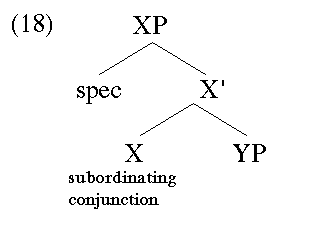
EESE 6/1995 - 123
Whereas in the previously discussed adjunct types, i.e. V1 and wh-
adjuncts, X and its maximal projection XP were unambiguously
classified as belonging to the universe of functional categories,
things turn out to be more complicated with the X-elements in
(18).
In the first place, both kinds of movement, i.e. verb movement
into X and wh-movement into specXP, are excluded.
The question of whether the X-elements in (18) are members of the
functional or the lexical universe is a long-standing one, as can
be seen from the number of publications dealing with the
categorization of these elements and from the uncertainties which
surface in different analyses of adjunct sentences.
In the following, I will take the adjunction prohibition
formulated by Chomsky (1986:6) as a criterion distinguishing
lexical and functional heads:
(19)
Adjunction is possible only to a maximal projection [...]
that is a nonargument.
What is to be expected is that adjunction to sentential elements
governed by a subordinating conjunction is possible if the
subordinating conjunction is a functional head but not if it is a
lexical head.
The phrases I take to be adjoined are indicated by bracketing.
It should be noted that native speakers' judgments vary
as to whether negative adverbial adjuncts, such as those
in (20a) and (20e), induce embedded inversion or not:
EESE 6/1995 - 124
(20)
- although [never before in her life] was her painting
career interrupted, she helped her husband and continued
to accumulate painting knowledge.
- Small areas aren't right for [while being investigated]
they may lie next to areas that are well suited to that crop.
- If [while applying for national support] we joined the
Common Market, our food subsidies would probably be
replaced by a system of tariffs.
- Not only is it these two things that customers want, but
they also want well-priced special offers and we private
retailers must take the burden out of everyday shopping
and make it as easy as we can for these shoppers in case
[despite paying horrendous rents] we lose their custom.
- In some ways it will be a testing occasion for him,
although some think his position unassailable simply
because [never again] will there be somebody like him.
- So if you are made of atoms, you are just a big machine;
and sincecaus [should my theory prove right] the universe
is also made of atoms, it is just a supermachine.
- It has been repeatedly pointed out that the Chancellor's
measures to restrict sales in the home market in order
[by all means possible] to increase exports are quite mistaken
and are having the opposite result.
- *She got nervous while [at the conference] she was
waiting for her publisher to show up.
- *From the standpoint of the army of duffers, however,
this was easily the most heartening exhibition they had had sincetmp
[while quite sucessful] Ben Hogan fell upon evil ways during
his heyday and scored an 11 in theTexas Open.
- *You will have to wait with your novel until [when you
are in London] you find a publisher.
- *I seemed to know what they were going to say long before
[while we were driving home] they said it.
- *After [a few hours ago] Mr Lloyd and his delegation
landed at Accra this morning, hundreds of shop assistants
demonstrated outside the British-owned Kingsway Stores,
the largest in town.
EESE 6/1995 - 125
On the basis of adjunction prohibition to L-marked elements, the
subordinating conjunctions before, after, until and the temporal
variant of since and while can be classified as L-marking heads,
whereas although, because, for, if, in case, in order and the
causal variants of since cannot. The temporal elements L-mark
their sentential complements whereas the others do not. Instead
they form extended projections with their structural complements.
These two relations between head and maximal sister are given with
L for lexical heads in (21), and with F for functional heads in
(22):
EESE 6/1995 - 126
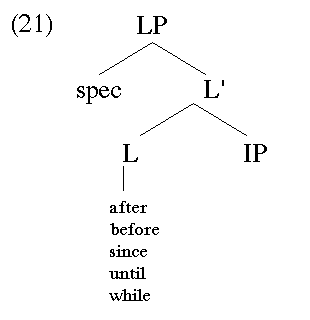

EESE 6/1995 - 127
I take the fact that adjunction to the complements of after,
before, temporal since, until and while is not possible as
evidence for their being L-marking heads, i.e. these heads are
members of a lexical category. With respect to the relation
between the elements in (22) and their structural complements, I
assume, again on the basis of the adjunction test, that L-marking
is not involved; adjunction to the structural complements of the
heads in (22) is possible.
That the relation between after, before, temporal since and until
and their structural complements can be captured by argument
structure-driven properties, i.e. by the assignment of the
governing head's internal theta-role to its maximal sister, comes
as no surprise if we think of the properties these items display
in other linguistic contexts.
After, before, temporal since and until are elements that allow for categorial variation of their internal argument; a property which is considered typical of lexical heads.
A further lexical property is Case-marking. As is well known,
after, before, temporal since and until assign case to their
nominal internal arguments. In their function as subordinators,
however, after, before, temporal since and until cannot be
observed to be case-assigning heads (Dubinsky and Williams
1995). While exclusively takes a sentential internal argument, the
prepositional counterpart during, on the other hand, takes a nominal internal argument to which it assigns both a theta-role
and case.
EESE 6/1995 - 128
What is striking about after, before, temporal since
and until, if their internal argument is propositional, is that it must
be the extended projection of a verb. So-called small clauses,
which are propositional as well, are excluded as internal arguments.
As can be seen in (23), there are no restrictions on the verb in the
embedded clause requiring it to be finite or infinite:
(23)
- He took a shower before he left home/leaving home.
- He took a shower after he came home/coming home.
- Since I moved here/moving here, I have felt more relaxed.
- Until I met your parents/meeting your parents, I had no
idea that you were annoyed with me.
Small clauses, as in (24), are excluded as internal arguments of
after, before, temporal since and until. This is due to the fact
that the events small clauses denote cannot be interpreted as
being anterior or posterior with regard to the matrix. The only
temporal interpretation they can receive is that of being
contemporaneous with the matrix, as the examples in (25) show:
(24)
- *After in hospital for two weeks, he felt better.
- *He left before in a bad mood.
- *Since a teacher, she hasn't seen her family.
- *Until examined, he will not apply for a job.
EESE 6/1995 - 129
(25)
- She admitted driving while under the influence of
alcohol.
- Fenwick had been convicted of taking without consent,
driving while disqualified, using an uninsured vehicle, and
using obscene language at a Durham court in 1956.
- Unfortunately this gifted artist was killed while on a
seal-hunt soon afterwards.
- While in Dublin she befriended a Mrs Gunning and her
family.
Despite the fact that although, because, for, if, in case, in
order and the causal variant of since do have autonomous
semantics, a property which typically is not associated with
functional heads, these elements obviously do not have an internal
theta-role which they could assign to their maximal sister. The
relation between functional heads and their structural complements
is generally assumed to be biunique. This biuniqueness concept is
conveyed by both Extended Projection and f-selection (Grimshaw 1991;
Abney 1987; Fukui and Speas 1986). Categorial variation within the
complement to such items is not expected. But consider (26) and (27):
EESE 6/1995 - 130
(26)
- The hand-over, due in September, was delayed because of
the Berlin crisis.
- The cannula was left in situ for several days following
the exchange in case of emergency, but was finally removed on
June 12th, when nearly all bleeding had stopped.
(27)
- Although too lazy to apply formally, he managed to get
the job.
- If successful, they would take into the city more than
3,000 houses which they have built in the Parson Cross area,
and more than 600 Wortley council houses, as well as
eight schools, a clinic and two parks.
- Unless in hospital, you have no opportunity to see your
doctor twice a day.
Under the premise that the structural complement is propositional,
because and in case, in (26), allow for nominal maximal sisters.
As will be seen, there is good evidence for dual categorization of
the elements because and in case. In (28), because and in case
assign a theta-role to their nominal sister, hence adjunction to
the nominal constituent introduced by of is not possible:
(28)
- *The hand-over, due in September, was delayed because
[last year/whether you believe it or not] of the Berlin crisis.
- *The cannula was left in situ for several days following
the exchange in case [during the treatment] of emergency, but
was finally removed on June 12th, when nearly all bleeding
had stopped.
Further evidence for describing because and in case in these
contexts as lexical heads comes from case theory. Because and in
case qualify as lexically-inherent case assigners.
EESE 6/1995 - 131
Of in these constructions can be considered to be the realization of the case
assigned (Rauh 1993; Lamontagne and Travis 1986; Huppertz 1992;
Löbel 1992).
Due to the fact that because and in case, in (26), assign both a
theta-role and lexically-inherent case to the nominal sister,
these elements have to be doubly categorized. The theta-
and case-assigning variant, given in (29), does not form
an extended projection with its complement, i.e. it is not
nominal, whereas the non-theta and no-case-assigning
variant, given in (30) does form an extended projection
with its verbal complement:
EESE 6/1995 - 132
(29) the lexical variants of because and in case
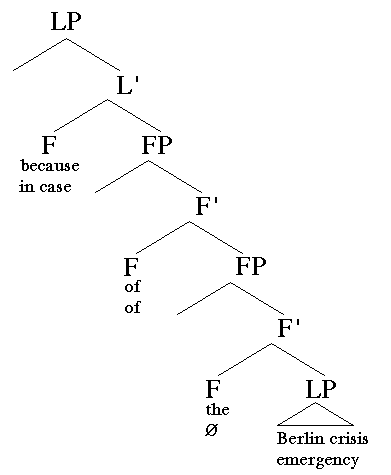
EESE 6/1995 - 133
(30) the functional variant of because and in case [because/in case we lose their custom]:
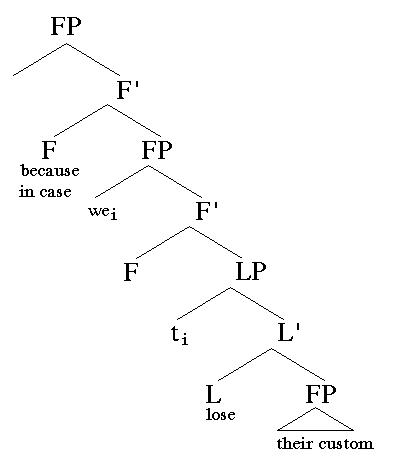
EESE 6/1995 - 134
As can be seen from the data in (27), categorial variation in the
complements to functional heads is possible. Besides sentential
complements, although, if and unless allow for small clause
complements. In these constructions, cf. those in (24), the events
referred to by the small clauses are interpreted as
contemporaneous with the matrix.
At a first glance, it might appear as if in order, in (31), allows
for categorial variation within its complement:
(31)
- She came home early in order to get some sleep.
- She typed the paper in order for him to get some sleep.
- She typed the paper in order that he might get some
sleep.
In (31a) and (31b), the sentential complements are infinite, the
difference between the two constructions being that the former
does not contain a lexical subject, whereas the latter does. In
(31c), the complement is a finite one.
Under Extended Projection, however, these complements do not count
as categorially distinct. They are perfect Extended Projections of
their verbal heads. In order, in all cases, is the highest head
within the Extended Projection of the verb.
EESE 6/1995 - 135
The data, I think, show very clearly that, in the first place, the
set of lexical items referred to as subordinating conjunctions is
far from being homogeneous, thus rendering a uniform
categorization untenable. Second, a division of the set of
subordinating conjunctions along the functional-lexical dichotomy
turns out to be problematic, since the set of items displays mixed
properties. On the one hand, there are the temporal subordinators
(after, before, since, until and while), which display purely
lexical properties such as having an argument structure; and on
the other there is the set of non-temporal subordinators which is
characterized by displaying mixed properties: With respect to
their external syntax they behave like lexical heads in that they
have an external argument, qualifying the phrases they head as
predicates. With respect to their internal syntax, they behave
like functional heads in that the relation between these heads and
their complements is functional rather than lexical, i.e. it does
not involve L-marking.
In conclusion I want to briefly discuss the external structure of
sentences introduced overtly by a subordinationg conjunction.
I will assume that these constructions, too, are one-place
predicates. The difference between predicates involving movement,
such as the V1 and the wh-variant, and those introduced overtly
lies in how predicatehood is achieved. While the former are
conceived as predicates by virtue of the operator in specXP,
the latter are predicates by virtue of their external argument,
as is shown in (32):
EESE 6/1995 - 136
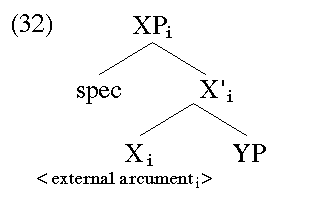
EESE 6/1995 - 137
In this paper I compared three types of sentential adjuncts in
English. These three types, as has been argued, fall into two
classes, one of which involves syntactic movement while the other
does not.
I argued that sentential adjuncts that involve wh-movement or verb
movement are functional in nature, i.e. the adjunct is the
extended projection of the verb.
With respect to sentential adjuncts that do not involve syntactic
movement, i.e. those which are lexically overtly marked as
subordinate, it turned out that they cannot be treated as
categorially uniform in terms of lexical vs. functional
categories. Taking the adjunction prohibition (Chomsky (1986:6))
as a diagnostic test for argumenthood of a maximal projection, I
argued that only a subset of subordinating conjunctions, namely
the temporal ones (23), could be unambiguously assigned the status
of lexical heads. Further evidence for assigning these elements
the status of lexical heads come from categorial variation within
their structural complement.
The set of subordinators in (22), on the basis of the same tests,
could not be assigned the status of lexical heads.
The expectation that these elements, which display some of the
properties of functional heads, do not allow for categorial
variation was not borne out (cf. examples (27), (31)).
EESE 6/1995 - 138
Unlike their internal structure, which is not at all homogeneous,
the external structure of subordinate clauses is relatively
homogeneous. It is homogeneous in so far as the subordination
types discussed in this paper can be uniformly characterized as
being instances of predication. Predicatehood, however, is arrived
at by different means.
In the case of the V1 and the wh-variants, repeated as (33) & (34)
respectively, predicatehood is based on the operator in specXP,
i.e. it is derivative:
EESE 6/1995 - 139
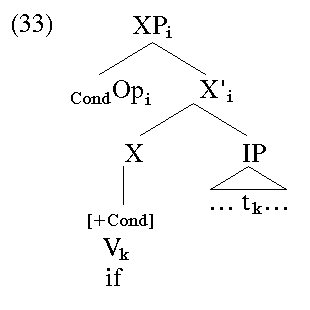
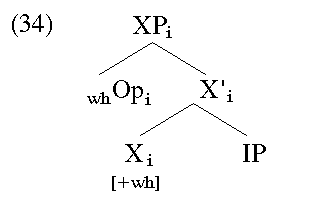
In the case of overtly introduced subordinate clauses as in (35),
however, predicatehood is achieved via the external argument of
the heads under consideration, and thus a lexically defined
property.
EESE 6/1995 - 140
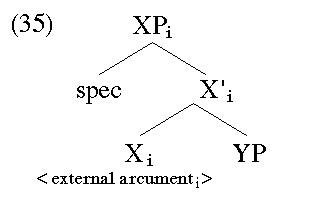
EESE 6/1995 - 141
Abney, S.P. (1987).The English Noun Phrase in Its Sentential Aspect.
Ph.D. diss., MIT.
Allen, E. & A. Mason (1939/1965). An English Grammar of Function.
London: Edward Arnold.
Brame, M. (1982). The head-selector theory of lexical specifications
and the nonexistence of coarse categories. Linguistic Analysis 10:
321-25.
Bresnan, J. (1970). On complementizers: toward a syntactic theory of
complement types. Foundations of Language 6: 297-321.
Bresnan, J. (1972). Theory of Complementation in English Syntax.
Ph.D. diss.,MIT.
Browning, M. (1991). Null Operator Constructions. New York: Garland
Publishing, Inc.
Chomsky, N. (1986). Barriers. Cambridge, MA.: The MIT-Press.
Chomsky, N. (1989a). A generalization of X-bar theory. In: Borg, A.,
S. Somekh & P. Wexler (eds.). Studia Linguistica et Orientalia
Memoriae Haim Blanc Dedicata. Wiesbaden: Verlag Otto Harrassowitz,
86-93.
Chomsky, N. (1989b). Some notes on the economy of derivation and
representation. MIT Working Papers in Linguistics 10: 43-74.
Chomsky, N. (1993). A minimalist program for linguistic theory. In:
Hale, K. & S. Keyser (eds.). The View from Building 20. Essays in
Honor of Sylvain Bromberger. Cambridge, MA.: The MIT Press, 1-52.
EESE 6/1995 - 142
Deutschbein, M. & H. Klitscher 1959. Grammatik der Englischen
Sprache auf wissenschaftlicher Grundlage. Heidelberg: Quelle &
Meyer.
Dubinsky, S. & K. Williams 1995. Recategorization of prepositions
as complementizers: The case of temporal prepositions in English.
Linguistic Inquiry 26: 125-37.
Emonds, J. 1976. A Transformational Approach to English Syntax.
New York: Academic Press.
Emonds, J. 1985. A Unified Theory of Syntactic Categories.
Dordrecht: Foris.
Freidin, R. 1971. Interpretive Semantics and the Syntax of English
Complement Constructions. Ph.D. diss., Indiana University.
Distributed by University Microfilms, Ann Arbor.
Fukui, N. & M. Speas 1986. Specifiers and projection. MIT Working
Papers in Linguistics 8: 128-72.
Grimshaw, J. 1979. Complement selection and the lexicon.
Linguistic Inquiry 10: 279-326.
Grimshaw, J. 1991. Extended Projection. Ms. Brandeis University.
Grimshaw, J. 1993. Minimal Projection, Heads and Optimality. Ms.
Rutgers University.
Grimshaw, J. 1994. Projection, Heads, and Optimality. Ms. Rutgers
University.
Haider, H. 1988. Matching projections. In: Cardinaletti, A. & G.
Cinque & G. Giusti (eds.). Constituent Structure. Papers from the
1987 GLOW Conference, 101-21.
EESE 6/1995 - 143
Haumann, D. 1990. Theta-Rollen Englischer Lokalpräpositionen: Syntaktische und Semantische Aspekte. M.A. thesis. Bergische Universitä:t-Gesamthochschule Wuppertal.
Haumann, D. 1993. Referential Arguments. Arbeiten des
Sonderforschungsbereichs 282. Theorie des Lexikons 44. Bergische
Universität-Gesamthochschule Wuppertal.
Hendrick, R. 1976. Prepositions and the X-bar theory. In: Emonds,
J.E. (ed). Proposals for Semantic and Syntactic Theory. Los
Angeles: UCLA Papers in Syntax, 95-122.
Higginbotham, J. 1985. On semantics. Linguistic Inquiry 16: 547-
93.
Huppertz, A. 1992. 'A phrase for Kase' - Zum syntaktischen
Anspruch einer KP-Analyse. Arbeiten des Sonderforschungsbereichs
282. Theorie des Lexikons 17. Bergische Universität-
Gesamthochschule Wuppertal.
Iatridou, S. & D. Embick 1994. Conditional inversion. To appear
in: NELS 24.
Jackendoff, R. 1973. The base rules for prepositional phrases. In:
Anderson, S. & P. Kiparsky (eds.). A Festschrift for Morris Halle.
New York: Holt, Rinehart & Winston, Inc., 345-56.
Jackendoff, R. 1977. X-bar-Syntax. A Study of Phrase Structure.
Cambridge, MA.: The MIT-Press.
Jespersen, O. 1924/1992. The Philosophy of Grammar. Chicago: The
University of Chicago Press.
Kayne, R. 1982. Predicates and arguments, verbs and nouns. GLOW
Newsletters 8: 24.
Kayne, R. 1990. Romance Clitics, Verb Movement, and PRO. Ms. CUNY.
ESSE 6/1995 - 144
Lakoff, R. 1968. Abstract Syntax and Latin Complementation.
Cambridge, MA.: The MIT-Press.
Lamontagne, G. & L. Travis 1986. The case filter and the ECP.
McGill Working Papers in Linguistics 3: 51-75.
Lasnik, H. & M. Saito 1992. Move à. Cambridge, MA.: The MIT-Press.
Lightfoot, D. 1979. Principles of Diachronic Syntax. Cambridge:
Cambridge University Press.
Löbel, E. 1992. KP/DP-Syntax: Interaction of case-marking with
referential and nominal features. Arbeiten des
Sonderforschungsbereichs 282. Theorie des Lexikons 33. Universität
zu Köln.
Manzini, R. 1992. Locality. A Theory and Some of Its Empirical
Consequences. Cambridge, MA.: The MIT-Press.
Müller, G. & W. Sternefeld 1993. Improper movement and unambiguous
binding. Linguistic Inquiry 24:461-507.
Muysken, P. & H. van Riemsdijk 1986. Projecting features and
featuring projections. In: Muysken, P. & H. van Riemsdijk (eds.).
Features and Projections. Dordrecht: Foris, 1-30.
Ouhalla, J. 1991. Functional Categories and Parametric Variation.
London: Routledge.
Pollock, J.-Y. 1989. Verb movement, universal grammar and the
structure of IP. Linguistic Inquiry 20: 365-424.
Pollock, J.-Y. 1991. Sur quelques différences de comportement
entre arguments et circonstants: îlots adverbiaux et
extractibilité. In: Guéron, J. & J.-Y. Pollock (eds.). Grammaire
Générative et Syntaxe Comparée. Paris: Centre National de la
Recherche Scientifique, 83-106.
EESE 6/1995 - 145
Radford, A. 1990. Syntactic Theory and the Acquisition of English
Syntax. Oxford: Basil Blackwell.
Rauh, G. 1993. Grammatische Kategorien. Arbeiten des
Sonderforschungsbereichs 282. Theorie des Lexikons39. Bergische
Universität-Gesamthochschule Wuppertal.
Riemsdijk, H. van 1978. A Case Study in Syntactic Markedness: The
Binding Nature of Prepositional Phrases. Dordrecht: Foris.
Riemsdijk, H. van 1990. Functional prepositions. In: Pinkster, H.
& I. Genee (eds.). Unity in Diversity. Papers Presented to Simon
C. Dik on his 50th Birthday. Dordrecht: Foris, 229-41.
Rizzi, L. & I. Roberts 1989. Complex inversion in French. Probus
1.1: 1-30.
Rizzi, L. 1991a. Residual Verb Second and the Wh-Criterion.
Technical Report in Formal and Computational Linguistics, 2.
Université de Genéve.
Rizzi, L. 1991b. Relativized Minimality. Cambridge, MA.: The MIT-
Press.
Rosenbaum, P. 1967. The Grammar of English Predicate Complement
Constructions. Cambridge, MA.: The MIT-Press.
Schibsbye, K. 1965. A Modern English Grammar. London: Oxford
University Press.
Speas, M. 1990. Phrase Structure in Natural Language. Dordrecht:
Kluwer Academic Publishers.
Stowell, T. 1981. Origins of Phrase Structure. Ph.D. diss., MIT.
Stuurman, F. 1991. If and whether: Questions and conditions.
Lingua 83: 1-41
EESE 6/1995 - 146
Sweet, H. 1891/1968. A New English Grammar. Logical and
Historical, Part I. Oxford: Clarendon Press.
Vikner, S. 1994. Course material presented at Gerona International
Summer School in Linguistics, 1994.
Webelhuth, G. 1989. Syntactic Saturation Phenomena and the Modern
Germanic Languages. Ph.D. diss.,UMass.
Webelhuth, G. 1990. Diagnostics for structure. In: Grewendorf, G.
& W. Sternefeld (eds.). Scrambling and Barriers. Amsterdam:
Benjamins, 41-75.
Williams, E. 1980. Predication. Linguistic Inquiry 11: 203-38.
Williams, E. 1987. NP trace in theta theory. Linguistics and
Philosophy 10: 433-47.
Zwarts, J. 1992. X'-Syntax - X'-Semantics. On the Interpretation
of Functional and Lexical Heads. Utrecht: OTS Dissertation Series.
Corpora:
Francis, W.N. 1964. Brown Corpus of American English. Providence,
RI: Brown University, Department of Linguistics.
Johansson, S. et al. 1978. The Lancaster-Oslo/ Bergen Corpus of
British English, for Use with Digital Computers. Oslo: University
of Oslo, Department of English.
Dagmar Haumann















